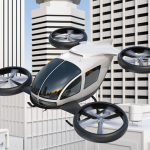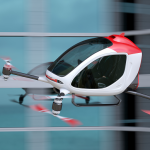S
ociety has been obsessed with the idea of flying cars ever since the Jetsons graced TV screens back in the 1960s. Since then, flying cars have been the ultimate symbol of the “future.” It appears the future is nearer than ever as a practical solution is emerging for urban air mobility (UAM).
Instead of sitting in the back of a musty city taxi in NYC traffic, imagine hopping in a flying taxi and arriving at your destination in a cool, traffic-free five minutes. According to Roland Berger’s study, by 2050, the passenger UAM industry will generate revenues of almost $90 billion a year, with 160,000 commercial passenger drones plying the skies.
Smart Cities
Dealing with a growing population and no room to build, Europe major metropolitan cities are facing challenges controlling pollution and traffic. The problem won’t go away anytime soon. Statistics show that by 2030, 60% of the world’s population will be urban. This significant population growth is expected to create a need for innovative mobility options as ground infrastructure becomes increasingly congested. This is why officials are now seriously looking into providing people with a safe, sustainable, and convenient solution that leverages the airspace above metropolitan cities.
In terms of transportation, the congestion and pollution from traffic, millions of cars, and everything in between, these cities are now being forced to come up with more sustainable intercity mobility solutions. Enter, the UAM Initiative of the European Innovation Partnership on Smart Cities and Communities (EIP-SCC). The initiative aims to bring together resources, including cities, citizens, companies, and research professionals, to boost practical studies on implementing initial UAM experiments. The UAM Initiative is on a city-centered approach, with a diverse set of showcase projects in cities and regions. All with the goal of developing concrete solutions for urban air mobility to make it the chosen mode of transportation in the near future.
eVTOL
As UAM starts to be proven in cities, it is expected to become an increasingly vital part of our transportation system in the next few years with the introduction of eVTOL aircraft. These new, battery-powered rotorcraft use an array of emerging advanced technologies and are expected to be quieter and safer than traditional helicopters.
Experts believe eVTOLs have the potential to transform short-range air transportation, especially for people and companies that currently use business aviation.
Benefits of UAM
UAM is a mode of transportation that is sustainable, safe, and secure. It could be the answer that major cities have been looking for, for decades now. Traffic, pollution, overpopulation are all leading city officials to scramble to find a solution. With UAM, roadways will be less crowded, traffic numbers will plunge, and pollution will lessen.
UAM will make getting from point A to point B faster, cheaper, and better for the environment.
Challenges of UAM
One of the biggest challenges facing urban air mobility is social acceptance. People have a hard time trusting autonomous flight, whether they are taking a flying taxi to work or having a package delivered via drone. In order to ease people’s concerns about UAM, leaders will have to make sure people have their questions answered and their voices heard so they can start to better understand and, thus, accept urban air mobility as the way of the future. Manufactures establishing close relationships with local leaders who have a key role in communicating and supporting the change is an extremely important component of growing social acceptance.
UAM’s challenges won’t end when they’re up and running (or should we say flying), however. They will need to make good on their promise that UAM is a sustainable, safe, and secure transportation mode. UAM will have to prove that it’s not a nuisance, but rather it’s a necessity and that it actually does make life easier.
In Europe, digital U-space refers to all of the infrastructures that will make it possible to manage UAM transport. In terms of UAM regulation, the digital U-space will likely be an automated system thanks to advanced technologies like AI. It will be possible to automatically manage and regulate different aspects of UAM.
It’s very exciting to think that the world is so close to implementing flying modes of transportation. Though there’s much to still be determined, it’s safe to say that the successful emergence of sustainable urban air mobility will largely depend on cities and countries’ commitment to guarantee compliance with safety rules and offer new mobility opportunities that will improve citizens’ quality of life.



